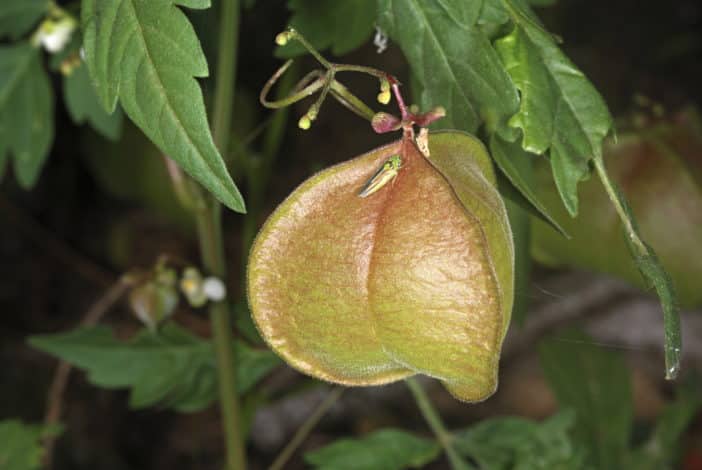Heart Seed

The heart seed also called balloon vine, is a handsome annual climbing plant that originated in India but is now also cultivated in southern Germany and Switzerland (especially in wine-growing areas). It bears striking, balloon-like fruits containing pea-sized seeds with a heart-shaped mark. The heart seed belongs to the soap tree family (Sapindaceae). The famous Swedish naturalist Carl von Linné gave the plant the scientific name Cardiospermum halicacabum in 1753. Cardiospermum translates to “heart seed” and refers to the black seeds that bear a white heart-shaped mark. The term “halicacabum” is the Greek term for salt barrel, which is due to the inflated appearance of the fruits.
Since the heart seed contains a lot of foaming saponins, its seeds were often used for washing in earlier times. In some cases, however, they also served as a substitute for buttons or rosary beads. In Indian and Caribbean regions, heart seed tea is prepared from the leaves: It is said to stimulate labor in pregnant women. Other traditional uses include respiratory diseases, rheumatism, menstrual disorders, wound healing disorders, and digestive and urinary tract disorders.
Heart seed and its importance in homeopathy, dermatology and cosmetics
Numerous studies have already shown that the heart seed has an anti-inflammatory, soothing and anti-itching effect on skin and mucous membranes. Nevertheless, the heart seed still belongs to the relatively new remedies, because its effectiveness has been described in Europe only for about twenty years.
The plant is recommended for external treatment of dry, itchy skin, as well as dermatitis and eczema. Cardiospermum halicacabum extract, due to its antioxidant effect, can be used to treat conditions related to oxidative stress and inflammation. It shows good results in neurodermatitis (atopic dermatitis), desiccation eczema (exsiccation eczema), psoriasis, hives, as well as allergic contact eczema. The heart seed protects the skin from moisture loss and reduces redness. Furthermore, it can support the healing of painful cracks that occur, for example, with very dry skin.
In the case of eczematous dermatosis, an external therapy with the heart seed should lead to a state that the local application of corticoids can be completely dispensed with in the best case. It is not for nothing that the creeping plant is often referred to as a herbal cortisone. Although dermatological products containing the heart seed are not quite as effective as conventional cortisone, no severe side effects are to be expected. One could also say that preparations with the creeping plant perfectly bridge the gap between a classic basic care with fatty products and cortisone-containing preparations. Last but not least, the heart seed also serves as a reliable relapse prophylaxis in the case of clinical pictures such as inflammatory skin changes. The fresh above-ground parts (herb or leaves) of the flowering heart seed are usually used for formulations, from which a so-called mother tincture (an ethanolic extract) can be produced. This mother tincture can be easily added to a wide variety of formulations. In homeopathy, Cardiospermum globules are often administered.
The possible applications in dermatology and cosmetics are wide-ranging. Whether body care oil, hand and nail care, lip balm, sun and day care, lotion or even for shaving and beard care, cardiospermum lends itself wherever the skin is highly stressed and/or inflamed. As a scalp fluid, it relieves annoying itching. However, creams and ointments with the heart seed are considered to be particularly effective in acute cases. So if the skin is very itchy, the affected area is smeared with a heart seed ointment several times a day. In the case of very acute symptoms, ointment compresses are also a good option.
The ingredients of cardiac seed
The oil content of Cardiospermum halicacabum seeds is extremely high, at around 33 percent. Of particular importance are long-chain fatty acids such as lignoceric acid, arachidic acid, stearic acid and oleic acid. But the other parts of the plant also score with valuable ingredients. Tannins, triterpene saponins, pentacyclic triterpene glycosides, flavonoids (including apigenin and luteolin), alkaloids and phytosterols are particularly noteworthy. The flavones and flavonol glycosides play the main role in the anti-eczematous effect of the plant.
The ingredients of the herbaceous creeping plant are well tolerated. Hypersensitivity reactions have been observed only very rarely. According to current knowledge, the use of preparations containing the heart seed is also possible over a longer period of time without any problems. Self-treatment is also considered harmless when handled responsibly. Furthermore, depending on the concentration, the products are also suitable for children.
Fact Sheet Heart Seed
INCI: Cardiospermum Halicacabum Flower/Leaf/Vine Extract
Botanical name: Cardiospermum halicacabum
CAS number: 89958-27-0
EINECS/ELINCS-Nummer: 289-651-1
Alternative names: Monk’s head, canphuti, balloon vine
Action: strong anti-inflammatory, protects the skin from excessive moisture loss, acts against skin redness, sunburn and itching
Indications: for eczema, neurodermatitis, psoriasis, hives, as well as for dry and/or inflamed skin, ideal as a herbal and very well tolerated substitute for topical glucocorticoids
Heart seed in sophisticated cosmetics from Cosmacon
Heart seed extract proves excellent for almost all allergy-related and inflammatory diseases of the skin, eczema, hives and nettle fever, psoriasis and atopic dermatitis. The ingredients of the climbing plant Cardiospermum halicacabum are very well tolerated and a gentle alternative to cortisone. Thanks to its anti-inflammatory, itch-relieving and skin-caring properties, the heart seed can be integrated into numerous sophisticated formulations. Ask us: we will be happy to support you in planning, development and implementation!
Sources:
Cardiospermum halicacabum in atopic dermatitis: Clinical evidence based on phytotherapic approach.; Fai D, Fai C, Di Vito M, Martini C, Zilio G, De Togni H. Dermatol Ther. 2020 Nov;33(6):e14519.
Antioxidant and Antiinflammatory Effects of Epilobium parviflorum, Melilotus officinalis and Cardiospermum halicacabum Plant Extracts in Macrophage and Microglial Cells.; Cells. 2021 Oct 8;10(10):2691.
Antifungal activity of Cardiospermum halicacabum L. (Sapindaceae) against Trichophyton rubrum occurs through molecular interaction with fungal Hsp90.; Drug Des Devel Ther. 2018 Jul 12;12:2185-2193.
Antimicrobial properties of the medicinal plant Cardiospermum halicacabum L: new evidence and future perspectives.; Eur Rev Med Pharmacol Sci. 2019 Aug;23(16):7135-7143.
Data on the inhibitory effect of traditional plants from Sri Lanka against tyrosinase and collagenase.; Data Brief. 2018 Aug 30;20:573-576.
